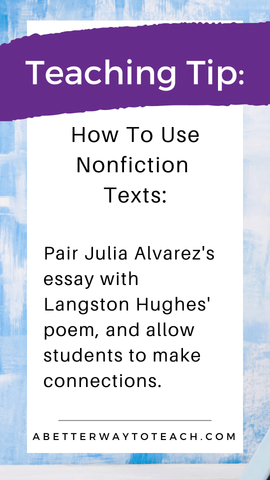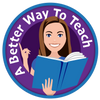Nonfiction texts are incredibly valuable for your secondary ELA classroom, and there are so many things you can do with them, from pairing them with poetry to using them as springboards into discussion about societal issues.
One of my favorite classes to teach is AP Lang because it is packed to the brim with nonfiction, but you know what's funny? I didn't even read nonfiction until I was in my late 20s. I'm a lover of literature (as you probably are if you're an English teacher). So, if you are like me, and you have come to the world of nonfiction a little later, I've got good news: we've narrowed down some amazing nonfiction texts to start using in your classroom this week. No need to sort through the bowels of the internet to piece something together.
This is a collaborative blog post where I include my favorite nonfiction text to teach, and my fellow teacher friends chime in on theirs!

A Nonfiction Text That You Can Pair With Poetry
Jeanmarie from McLaughlin Teaches English loves to be able to pair non-fiction with fiction and poetry. So, when she stumbled upon the essay, “I Too, Sing America” by Julia Alvarez, she was excited for the possibilities because she was immediately reminded of the poems by Walt Whitman and Langston Hughes.
In this essay, Alvarez recounts the role that books and education played in her early years, growing up in the Dominican Republic. She chronicles how she felt lost once she came to America because she had lost almost everything in the move. It was the 1960’s and she faced prejudice and a melting pot mentality. She struggled to find her place. That is until she found the pair of poems “I Hear American Singing” by Walt Whitman and “I, Too” by Langston Hughes.

Langston Hughes’ words resonated for her. It made her realize there was a place for her and she talks about the importance of “one human family.” She ends with is own poem: “I, Too, Sing America.”
How To Teach This Nonfiction Text
Have students first read the essay for its big ideas. Have them annotate for anything that pertains to identity. Then share the three poems (Alvarez’s poem appears at the end of her essay) to make comparisons. Students could work in groups on one poem and then share or each group could work on all three poems. Consider a three way venn diagram or having the students begin with dialectic journals. Your choice. Enjoy this non-fiction-poetry pairing. Your students certainly will.
A Nonfiction Text With Unlimited Possibilities: Teen Vogue
It’s difficult to pick just one non-fiction piece so why not look to a source of many and offer options to students?
Lesa from SmithTeaches9to12 loves Teen Vogue to offer different points of view on a variety of topics! You might be thinking this publication is just about fashion or style, and that certainly exists, but it’s so much more than that too!

The Politics section focuses on government, environment, immigration, justice, and history! Here are just a few options: this one about young voters or this one with advice to current students from graduating seniors or even this one about climate change action in the face of wildfires in California.
The Culture section is jam-packed with music, movies, tv, books, and tech. This article with 8 profiles of creators in Hollywood making a difference combines pop culture with difference-making.
The Identity section includes health and wellness as well as relationships and advice, but the best part of this section is Voices. In Voices current and trending events and ideas are addressed in a teen-friendly and teen-accessible way. This one about residential schools or this one about Muslim women in sport could be great.
Lesa uses a variety of articles about self-love and self-care as part of an SEL approach in her English courses. Luckily Teen Vogue has lots to work with on those topics too!

To avoid having to sift through the site, check out this ready-made lesson with suggested articles, key questions for reflection and discussion, plus extension activities too. This lesson can work at any time of year but Lesa finds it particularly helpful as we approach Valentine’s Day. The lesson shifts the focus away from romantic love and this has been really helpful for all students in class!
Nonfiction Text For Developing Empathy
And now it's my pick! I have a deep love for this article by Tom Junod about Mr. Rogers that first appeared in 1998 in Esquire.
Maybe you've seen the film staring Tom Hanks, but didn't know that you can still find that article? Well, yep! You can, and it is outstanding. You can also go to Esquire and see the actual article (but you have to pay).
I actually used this article on a job interview a few years ago. For the interview I was required to teach a class of AP Lit students whom I'd never met before. It was scary, to be perfectly honest. But the students loved the article and they did fabulous with that lesson (and I got the job!).
This article is so rich in use of language as well as it's structure, but perhaps the best thing about it is that it can actually serve to help teach empathy.
How To Teach It:
You can use the whole article, or you can condense it, and just focus on a few parts. I've got to say that using the whole article is quite powerful, and I'd strongly suggest doing the whole thing if you can. It's a long article, but students can still read and interact with it in a single class period.
I love having students focus on what sentences stand out to them in the article, and even having them jot down sentences that "pack a punch." Then we talk about why those sentences got their attention. Was it the imagery? The symbolism? The repetition?
After reading the article and discussing some particularly powerful sentences and the crafting of those sentences, I'll have students do what Mr. Rogers himself would do: ask the group to think about an adult who deeply impacted their life. Sit and think about them for 2 minutes (it describes Mr. Rogers doing this in the article).
After students have done this, I'll ask them to write about who they were thinking about. If we have time, I might have them go back and craft a few of their sentences in a way similar to Junod (i.e. using repetition or strong imagery).
If you want to see exactly what I used for my interview, check the lesson out here.
For most students, this is a powerful lesson that put them in a state of sincere gratitude for the adults in their lives.

Using nonfiction texts allows your students to jump into deep and meaningful topics without reading a full-length novel: they're accessible, relevant, and absolutely necessary for the ELA classroom.
Related Articles:
4 John Green Essays That Are Perfect for High School ELA - SmithTeaches9to12
11 Brilliant Strategies for Dialectic Journals to Better Close Reading - McLaughlin Teaches English
5 Ways To Celebrate Black Voices In Your ELA Classroom This Year (abetterwaytoteach.com)
21 Nonfiction Books for Secondary ELA Classrooms | SECONDARY SARA
Engaging Nonfiction for High School Readers - Write on With Miss G
BONUS: Grab a free lesson here!





Leave a comment